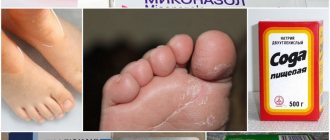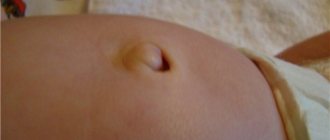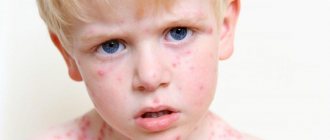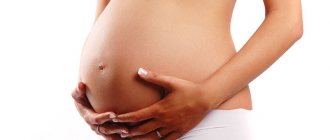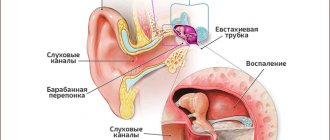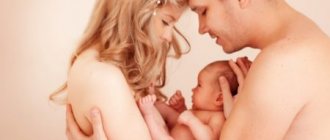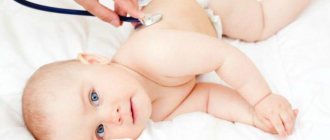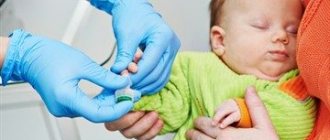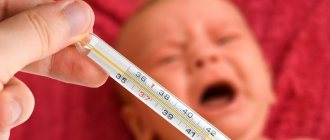Jaundice is a disease that causes yellowing of the skin and eye sclera. Color saturation may vary depending on the form of the pathology and the degree of its development. If the simplest form of the disease is observed - physiological jaundice in newborns, treatment at home will consist of taking baths with the addition of herbal decoctions. For other forms of pathology (hemolytic, mechanical or infection acquired inside the womb), the therapy will be slightly different. In any case, every woman planning to have a child needs to have a general understanding of how to identify jaundice and what actions need to be taken if it appears.
Causes
The physiological form, or postpartum jaundice, is a natural condition for a child. The main reasons for its occurrence are the breakdown of hemoglobin or bilirubin accumulated in the infant’s plasma, which changes the color of the skin and sclera to a yellowish tint.
In addition, jaundice can also be caused by:
- prolonged disruption of the mother’s hormonal levels: excess estrogen negatively affects the quality of breast milk, and the baby involuntarily receives the hormone during feeding;
- unbalanced diet of the mother;
- pathologies and delay in the development of the baby’s liver and gall bladder.
When bilirubin accumulates in the blood, a normally functioning liver disinfects it. Therefore, the development of jaundice in newborns occurs due to underdevelopment of the liver, dysfunction of the biliary tract, or pathological reabsorption of the final products of disinfection in the intestinal tract. If the level of bilirubin is excessive, the baby's body becomes intoxicated, which leads to complications in the form of a more severe form of jaundice - nuclear.
Other types of jaundice are also dangerous:
- hemolytic - occurs due to the breakdown of hemoglobin inside the womb;
- mechanical – for digestive pathologies accompanied by dysfunction of bile flow;
- caused by intrauterine infections when liver cells are affected.
If the baby has jaundice of the skin, then it is necessary to urgently seek medical help, since jaundice in newborns must be treated immediately. Therapy is usually complex - medications and traditional methods of treatment. The diet for jaundice is especially important for a nursing mother. Products that affect the functionality of the newborn’s liver and the ability to disinfect bilirubin are excluded from the diet.
What consequences can infant jaundice have?
Usually, breastfeeding jaundice and physiological jaundice in newborns have no consequences; when the yellowness of the skin disappears, nothing reminds of the disease.
Recently, neonatologists recognized these conditions as a variant of normal baby development.
The consequences of pathological jaundice depend on the reasons that caused it.
If you start treatment on time and do not deviate from the doctor’s recommendations, then most likely the disease will be completely overcome and will not leave behind any additional diseases.
Untreated or untimely treated jaundice in newborns does not go away without a trace; the consequences can be as follows:
- the risk of liver cancer in the future is greatly increased;
- weak immunity in the baby;
- cirrhosis and other liver diseases.
If the baby suffered bilirubin encephalopathy, and he did not receive medical care, the consequences may be partial or complete hearing loss, developmental delays, and paralysis.
A child with signs of jaundice should be constantly monitored by a doctor so as not to miss the development of severe forms of the disease and to prevent dangerous consequences.
A beautiful and long-awaited baby who was born suddenly turned yellow. On the third day after giving birth, just in time for the discharge that the whole family was waiting for, the baby acquired an unusual orange color, once and for all ending the mother’s dreams of a beautiful photo shoot with the newborn. Joyful thoughts were replaced by anxiety - what kind of jaundice is this and why is it dangerous? These questions are answered by the famous pediatrician, TV presenter and author of books and articles on children's health, respected by millions of mothers, Evgeniy Komarovsky.
Manifestations
Postpartum jaundice usually appears on the third day; The defining signs are yellowing of the baby's skin and sclera. The more intense the color, the higher the bilirubin content in the blood. You can notice yellowing of the skin when the level of the substance in the blood exceeds 35 µmol/l. This value can reach 250 µmol/l.
The degree of danger can also be judged by the location of yellowness on the child’s body. The wider the area of skin damage, the more serious the consequences will be. The main treatment for jaundice in newborns takes place at home, after the attending physician has prescribed a treatment plan. But in the case of the development of kernicterus, when the child exhibits dangerous symptoms in the form of vomiting, weakness, darkening of urine, the baby is left in the hospital, where he is under the constant supervision of medical workers.
In addition to the above symptoms, kernicterus in children is accompanied by:
- pronounced lethargy, loss of activity of the newborn;
- frequent regurgitation;
- disorders of sucking function;
- body tremors, tics, convulsive seizures.
As a rule, a severe form of jaundice is accompanied not by one sign, but by several.
It is quite easy to notice the pathological condition of a child during this period, but in no case should you endanger the baby’s life by self-treating jaundice at home; you must consult a doctor!
Sorbents for the treatment of jaundice
Bound bilirubin can be removed from the intestines by regularly taking sorbents, most often Enterosgel or Smecta . But you should not give your child medications without first obtaining the doctor’s approval, as they can cause bowel problems or, conversely, constipation, which can lead to even more serious complications.
Another natural sorbent is activated carbon; It can be given to newborns without fear. You need to dilute a quarter of a charcoal tablet in clean water (one teaspoon is enough) and give the product three times a day. It should be noted that natural sorbent can turn baby’s stool black - this is normal and does not pose any danger.
Signs of overheating in a newborn
Unfortunately, every little person perceives the sun differently and has its own maximum permissible dosage of its radiation. It is not uncommon for a baby to begin to feel unwell due to overheating, which manifests itself as follows:
- the child becomes lethargic
- there is an increase in body temperature,
- nausea and even vomiting are observed,
- redness of the forehead and cheeks.
Parents can help their child if they follow some rules aimed at alleviating his condition:
- It is necessary to give as much clean water to the baby as possible,
- avoid returning to the open sun,
- You can reduce the temperature by rubbing yourself or taking a cool shower.
If the baby overheats, it is necessary to give clean water to drink.
If all of the above measures do not have any effect, you should immediately call an ambulance.
Home treatments
Since jaundice can be treated at home during its normal course, gentle methods of therapy are used using herbs and infusions, which significantly speed up the healing process. It is also necessary to adjust the daily routine of both the baby and the young mother.
Light therapy
Bilirubin is sensitive to ultraviolet light, so sun exposure is one of the best ways to cure jaundice.
Medical institutions use special equipment to conduct treatment sessions throughout the entire therapy. Babies born in summer can be taken outside for a short time to sunbathe. You should not go out into direct sunlight; it is better to use diffused light with an exposure duration of no more than 10-15 minutes.
Diet of a young mother
There is no better cure for jaundice than breast milk. It contains all the useful and nutritious substances necessary for the baby's health. But if the mother’s diet is improper, the newborn also receives harmful components that can aggravate the course of the disease. Need to exclude:
- smoked meats;
- spicy foods;
- foods high in fat;
- marinades;
- semi-finished products;
- allergens;
- foods that promote excessive formation and accumulation of gases in the intestines.
It is preferable to eat fruits and vegetables, provided that the child is not allergic to them.
It is quite easy to determine this by eating a small piece of the product and feeding the baby with breast milk. You need to observe the baby’s reaction throughout the day. If the child does not have any rashes, then the product can be introduced into the daily diet. Particular attention should be paid to drinking - a young mother needs to drink at least two liters of water per day.
Folk remedies
If jaundice is detected in a newborn, treatment at home should be comprehensive. To do this, they not only take medications, but also use various lotions, baths, and compresses.
- Magnesia. At any pharmacy you can purchase a solution of magnesium sulfate, which is sold in standard ampoules. This tool is considered an excellent alternative to electrophoresis. Clean gauze is moistened in the solution and applied to the baby’s projection of the liver area for 15-20 minutes. The procedure should be carried out after feeding, which will help speed up the process of removing bilirubin from the body.
- Rose hip. The action of the berries is aimed at normalizing digestive function and removing toxic substances from the body. It is easy to prepare a rosehip decoction: 0.5 liters of water will require 100 g of berries, which need to be poured with boiling water and boiled for 10 minutes. The product is recommended for both mother and baby. The baby should be given a teaspoon of decoction after each feeding.
- Glucose. For jaundice in newborns, treatment must necessarily include replenishing glucose reserves in the body. Before you start giving a 5-10% solution to your baby on your own, you need to consult a doctor who will explain all the intricacies of this stage of therapy.
- Peppermint. Mint decoction can be given only if the baby tolerates it normally. You need to make sure that there are no rashes on the skin and no colic after taking the product. For a glass of boiling water you need to take 5 g of dry mint. Infuse the product in a thermos for two hours. The strained tea should be given a teaspoon twice a day after meals.
Baths based on decoctions of chamomile, calendula, and golden flower help speed up the process of removing bilirubin from the body . The only condition for bathing the baby is a healed umbilical cord. 200 g of any of the listed herbs are boiled in four liters of water for 30 minutes, then left under the lid for another half hour. The finished broth is filtered and the baby is bathed in it. The duration of water procedures is 15 minutes. After bathing, the baby should be dried and wrapped warmly.
All of the above remedies have proven themselves in the treatment of jaundice, but, as is known, self-medication is dangerous, especially for newborns. In any case, a visit to the doctor is mandatory, and you can start home therapy only after the doctor approves the plan.
Jaundice is a special symptom that manifests itself in infants in the form of changes in the color of the skin and sclera of the eyes. The yellow color appears depending on the intensity of the pathology. Jaundice in newborns does not require treatment at home in all cases. Quite often the symptom decreases as the baby grows older. However, there are other types of disease (for example, intrauterine) that require adequate therapy. Parents should know about the nature and causes of the pathology. A pediatrician will help cure it, prescribing a course based on the patient’s test results.
Today, phototherapy, a special diet for a nursing mother, is most often prescribed. Taking sorbents and other medications and bathing in a herbal bath also have a positive effect. It is also recommended to regularly drink a special solution of glucose along with rosehip decoction.
How is jaundice treated?
The most effective method of reducing bilirubin in the blood is phototherapy.
The baby is placed under special lamps that operate in the blue spectrum. When exposed to light, bilirubin is transformed into non-toxic lumirubin, which is quickly eliminated from the body.
Phototherapy of newborns with jaundice can be carried out both in the maternity hospital and in a children's hospital.
In large cities, you can rent a lamp for treating jaundice in a child. Therefore, if bilirubin does not go off scale and the baby’s condition does not cause concern, then therapy can be carried out at home.
At the same time, you should not forget to donate blood on time to determine the level of bilirubin.
The lamps are prescribed for 96 hours with breaks for feeding. To protect their eyes, babies are given special bandages or caps.
During phototherapy, the baby loses fluid, so when breastfeeding it is necessary to feed the baby on demand.
Side effects of light treatment: peeling of the skin, frequent bowel movements. These symptoms disappear as soon as treatment is completed. Read more about how many times a newborn should have stool>>>
After the end of phototherapy, choleretic and diuretic drugs are sometimes prescribed to complete the treatment:
- Hofitol is given to newborns with jaundice in the form of drops, three times a day, mixed with water.
- Ursosan is given to newborns with jaundice once a day, diluting part of the capsule contents in a small amount of water. Read also: When can you give water to a newborn?>>>
- It is convenient to give Ursofalk to the baby; for newborn jaundice, it is better to purchase this drug in the form of a suspension.
Ursosan and ursofalk reduce bilirubin in the blood within a few days.
- Among homeopathic medicines, doctors can recommend galstena . Galstena for jaundice in newborns is taken in the form of drops, 3 times a day. Before giving the medicine to the baby, the drops are diluted in breast milk.
Blood transfusions are used to treat severe forms of jaundice. This helps replace most of the red blood cells in the blood and, thereby, reduce bilirubin by half in one procedure.
One transfusion replaces up to 80% of the baby's blood. Taking blood from the mother is not allowed, so another donor is found for the child.
Physiological jaundice goes away on its own and does not require special treatment. However, the mother can help the baby quickly get rid of excess bilirubin:
- The best method of prevention is breastfeeding. It is important to put your baby to the breast immediately after birth. Colostrum contains components that stimulate the baby's intestines. Together with meconium (the first stool), bilirubin is removed from the body. Mother's milk is the best way to replenish fluid during phototherapy. Read more about breastfeeding and proper application>>>
- Sunbathing. In late spring, summer or warm autumn, you can move the stroller hood while walking so that the sun's rays fall on the baby's face. In winter, you can stand with the baby on the balcony, just make sure that the child does not freeze. Don't let the sun get into your baby's eyes. Vitamin D received by the baby helps remove bilirubin from the body.
- You should not give your baby glucose solution or rosehip decoction on your own; Only a doctor knows how glucose should be administered for jaundice in newborns.
Causes of pathology
Most often, jaundice in newborns appears immediately after birth. The situation is considered normal because it is caused by the following factors:
- The process of fetal hemoglobin breakdown continues in the skin.
- Bilirubin accumulates in the blood. This is a special substance that gives the skin its characteristic yellow color.
With jaundice, natural processes in the baby’s body are disrupted:
- The mother has a disturbance in the production of hormones. Breast milk is directly affected by estrogen. To remove it from the body, it will be necessary to use additional resources of the gastrointestinal tract.
- A woman does not adhere to a special diet during lactation.
- The baby's liver and some organs of the biliary system have not yet fully formed.
For a newborn, the manifestation of jaundice is considered normal between two weeks and a month. During this period, the color intensity may change.
Bilirubin is a special substance that tends to accumulate in the blood serum. The process occurs only if the baby’s liver has not yet fully matured. Against this background, insufficient outflow of bile is recorded. Products are absorbed into the intestinal walls without prior disinfection.
If bilirubin accumulates in the blood in large quantities, then the risk of intoxication in the child’s body increases. The symptom is serious and can lead to complications in the human body. Toxic substances negatively affect the brain and its stem, so the baby may develop a number of neurological diseases.
Children with jaundice should be under constant medical supervision. The dynamics are analyzed within two weeks. If there is no obvious improvement, then it is advisable to start a course of drug therapy.
There are also neonatal types of pathology that pose a serious threat to the baby’s health:
- If the breakdown of hemoglobin was recorded inside the mother’s womb, then the baby develops hemolytic disease.
- The liver cells were damaged due to the woman having an intrauterine infection.
- There are abnormalities in the digestive tract. In this case, obstructive jaundice is diagnosed.
In such cases, jaundice in newborns should be treated immediately. However, at the first stage, the causes and diagnosis are established. Next, the doctor needs to track the dynamics of changes in bilirubin. Only after this can you choose between traditional and medicinal methods. Additionally, the woman must adhere to a special diet. Foods that lead to exacerbation of pathology are completely excluded from the diet. In this case, it is possible to prevent liver infection and disturbances in the gastrointestinal tract.
What's happened?
Jaundice in newborns is a fairly common phenomenon; it is observed in 50-60% of full-term and 80% of premature babies. You shouldn't treat it like a disease. The child’s skin turns yellow for completely physiological reasons. Fetal hemoglobin in the baby's blood (which was natural for him during pregnancy) changes to normal human hemoglobin A. The baby adapts to the environment. Its enzyme system is immature, like its liver. It is this organ that is responsible for the excretion of bilirubin, which is formed in all people during the breakdown of red blood cells. These blood cells are constantly renewed, hence the need to “recycle” aging cells.
Main symptoms of the disease
Most often, a change in skin color in a baby is recorded on the third day after birth. The baby becomes significantly darker, and the skin acquires a pronounced brown color. This is how jaundice manifests itself in infants.
The final color of the skin largely depends on the level of bilirubin in the blood. Its amount can vary from 35 to 250 µmol/l. It is impossible to avoid serious consequences if the indicator reaches its maximum.
Physiological jaundice in newborns also manifests itself in the form of the following symptoms:
- severe anxiety;
- frequent regurgitation, which can lead to vomiting;
- general state of apathy and lethargy;
- characteristic change in urine color.
All these manifestations arise due to severe intoxication of the body. Parents are interested in the question of whether they are discharged from the maternity hospital in this condition. The feasibility of the process is assessed by the doctor. Based on tests and signs, he can prescribe treatment in a hospital setting. Here the dynamics and intensity of changes in bilirubin are monitored.
Kernicterus is characterized by the following symptoms:
- Lethargy and drowsiness in a child become more and more obvious every day.
- Spontaneous regurgitation or vomiting may be noticed from time to time.
- The sucking reflex becomes less and less.
- Periodic appearance of spontaneous muscle twitching.
Treatment of jaundice in newborns at home cannot continue in this case. The situation should be analyzed by a doctor. In some cases it is impossible to avoid hospitalization.
When does jaundice go away?
Physiological jaundice of newborns begins to subside when the baby is one week old. The signs of the disease completely disappear by the age of one month.
Pathological jaundice as a symptom can be eliminated quite quickly, within a few days. Today there are ways to quickly and safely remove bilirubin from the patient’s body.
It should be remembered that sometimes pathological jaundice and high bilirubin are symptoms of a serious disease, the duration of treatment of which depends on the situation and can be determined by a doctor.
Treatment methods for jaundice
Parents have a logical question: how to treat jaundice in a newborn? When choosing a course, the pediatrician takes into account the following important criteria:
- General condition of the baby.
- The presence of pathological processes in the past.
- Changes in bilirubin over time.
- Does the baby have any other illnesses?
In this case, parents at home are recommended to use the following therapeutic measures:
- Phototherapy and regular sunbathing.
- A newborn should be outdoors regularly.
- Medications should be taken only after consultation with the attending physician.
- Traditional methods also help eliminate symptoms. For this purpose, the baby is regularly bathed in chamomile decoction. Additionally, it is recommended to use rosehip decoction and glucose solution as mother's drink. These two drinks will help significantly improve liver function.
Basic principles of treatment of jaundice in newborns
Children with jaundice are treated at home in most cases. Important and determining factors in this matter are:
the baby’s health condition and pathological symptoms; causes of jaundice; bilirubin level and the dynamics of its decrease; presence of underlying diseases.
The complex of therapeutic measures for the treatment of jaundice in newborns includes:
Full breastfeeding, but be sure to follow a diet for jaundice. Phototherapy and sunbathing. Mandatory walks in the fresh air with a newborn. Medicines for jaundice: the use of sorbents (activated carbon, Smecta, Enterosgel), the appointment of hepatoprotectors (Galstena, Hofitol). Treatment with folk remedies at home: bathing children in herbal decoctions (calendula, chamomile), drinking rosehip decoction, taking a glucose solution, which improves liver function.
ethnoscience
If the decision was made to discharge the baby from the maternity hospital, then further treatment of the pathology will be carried out at home. Mommy should pay close attention to every symptom. Additionally, the attending physician monitors changes in the physiological state. If no improvement is observed, then it is advisable to change treatment tactics.
During the treatment of a baby, only those products that have been previously agreed upon with the attending physician can be used.
Rosehip decoction allows you to quickly and effectively remove toxic substances. To prepare it, you need to use three dried berries, which are carefully crushed and filled with boiled water. Just a glass of liquid is enough. To obtain the maximum amount of healing properties, the decoction must steep for at least five hours. Taking one teaspoon each time before feeding will help you get rid of jaundice. Parents should be extremely careful when using it if the child already has a known allergy.
These herbs help improve blood circulation and eliminate inflammation. The process leads to the rapid removal of bilirubin from tissues and blood.
You can make the decoction yourself. To do this, 200 grams of calendula and chamomile flowers are poured with one liter of water. Brewing should continue for at least 10 minutes. Infusion must be carried out for three hours. It is advisable to add the product every time while bathing.
The use of folk remedies for the treatment of jaundice
Prolonged physiological jaundice in newborns (except for complex and severe cases) is treated at home.
It’s more comfortable at home for both mother and baby, and the baby’s recovery is faster. But the entire period of therapy should be monitored by the attending physician, who prescribes treatment, notes the symptoms of this physiological condition and their changes during therapy, and carries out correction of therapy in children with jaundice.
All remedies, both medications and traditional methods of treatment, must be agreed upon with a specialist.
Benefits of breastfeeding for neonatal jaundice
Pediatricians recommend following a number of recommendations to quickly remove bilirubin from the blood and tissues, and first of all, frequent breastfeeding.
Breast milk proteins bind toxic breakdown products of bilirubin, and immunoglobulins activate the body’s resistance.
Also, natural feeding has a laxative effect, which stimulates the functioning of all organs of the digestive system.
A contraindication to breastfeeding with jaundice in children is only an immunological conflict between mother and child (by blood type and Rh factor), when there is a possibility that through milk the baby will receive antibodies that aggravate the breakdown of hemoglobin and the active release of bilirubin. In all other cases, breast milk is the best medicine for treating jaundice at home.
But a nursing mother must eat right: a proper diet for jaundice is the key to the rapid and intensive removal of bilirubin from the body.
It is necessary to exclude from the diet any foods that can cause digestive problems in the baby.:
spicy and fatty foods; smoked meats; marinades; shelf-stable products containing preservatives and dyes; allergens (citrus fruits, chocolate, red and orange fruits and vegetables, whole milk); foods that tend to produce increased gas (baked goods, sweets, grapes, carbonated drinks, strong tea and coffee); products that can cause stool retention.
Walking in the fresh air is considered an additional effective factor for treatment at home - this activates all metabolic processes in the baby’s body, including the detoxification function of the liver.
Phototherapy
Light therapy or treatment with ultraviolet rays is an important element of complex therapy for jaundice. This technique is used in specialized departments using special white or blue light lamps, but it can also be done at home - sunbathing or renting an ultraviolet lamp. When using lamps, special bandages and fiber optic blankets are applied to the baby’s eyes and body, and the course of treatment in most cases is 96 hours.
Ultraviolet rays accelerate the breakdown of bilirubin in tissues and stimulate its excretion from the body.
The baby receives natural ultraviolet light in the form of sunbathing - 15 - 20 minutes 2-3 times a day every day. This technique not only activates the binding of toxic products of hemoglobin breakdown, but is also considered an effective way to harden the baby.
The use of sorbents for the treatment of jaundice
Bilirubin in bound form is excreted in the stool - with a pronounced process of hemoglobin breakdown, a change in the color of the stool appears.
To remove bilirubin from the intestines, a natural sorbent - activated carbon and medications - Enterosgel or Smecta are used. The use of enterosorbents at home is possible only as prescribed by the attending physician; sometimes these drugs can cause constipation or, conversely, loose stools. Activated or white carbon for a baby is used in a dose of no more than 1/4 tablet 2-3 times a day, after dissolving in a teaspoon of boiled water.
After starting to use these medications, you need to monitor the condition of the baby. You also need to take into account that after taking activated carbon, dark inclusions appear in the baby’s stool or the feces may be dark in color.
Rosehip decoction for the treatment of prolonged jaundice
To quickly remove toxic products from the child’s body, you can brew a rosehip decoction at home in a thermos as a drink. To prepare a healing remedy, you need to take several dry rose hips (2-3), pre-chopped, and pour a glass of boiling water. Leave in a thermos for 5-6 hours. Give 1-2 teaspoons of rosehip decoction to the baby in between feedings. This drug should be prescribed with caution to children prone to allergic reactions.
Bathing in decoctions of medicinal herbs
Baths with herbal decoctions (calendula or chamomile) improve blood circulation in the skin, have a calming and anti-inflammatory effect and accelerate the removal of bilirubin from tissues.
To prepare a decoction at home, you need to take 200 grams of calendula or chamomile flowers per four liters of water, brew for 10 minutes and leave for 3-4 hours. This product is used for daily bathing of babies.
All these methods of therapy are considered auxiliary and are used only for prolonged neonatal jaundice. Therefore, parents should closely monitor the symptoms of this condition and immediately contact a specialist if signs of jaundice worsen.
Jaundice occurs in 60% of full-term babies and in 80% of infants who were born prematurely. The baby's skin, mucous membranes and eyeballs become yellow on the second or third day after birth. The symptoms do not affect the well-being of the newborn and disappear after 4–5 days. This is how physiological jaundice manifests itself, which does not need to be treated. There is also a pathological variety, from which phototherapy and sorbents can help.
Lactation with jaundice
In order to quickly remove bilirubin from the blood, a woman is not recommended to give up breastfeeding. Milk contains protein that quickly and effectively binds all toxic components. Thanks to this, the body’s resistance to harmful effects increases several times. Breast milk normalizes the baby's stool and improves the functioning of his digestive system.
Lactation should be abandoned only in case of an immunological conflict. In this case, the milk contains antibodies that will only worsen the overall situation. This clinical picture is rare, so breastfeeding specialists most often recommend continuing breastfeeding.
If the baby has been diagnosed with jaundice, the woman will have to follow a special diet. Thanks to this, it will be possible to achieve recovery within a short time. To quickly remove bilirubin from the blood, a woman should exclude from her diet foods that can lead to a malfunction in the digestive system:
- seasonings and fried foods;
- all varieties of smoked meats;
- tangerines;
- dishes that contain large quantities of dyes and preservatives;
- possible allergens;
- foods that can cause excessive gas in the baby or mother;
- ingredients that negatively affect stool.
To improve your overall well-being and health, it is recommended to regularly spend time in the fresh air. Walking improves metabolic processes and helps restore detoxification naturally.
Features of phototherapy
Exposure to light or ultraviolet rays is used to quickly relieve symptoms of jaundice. The process involves the use of a special lamp, which can have a white or blue glow. In the warm season, the tool can be replaced with regular sunbathing. However, with such an effect on the baby, he needs to cover his eyes and body with a special blanket.
Thanks to ultraviolet light, the process of bilirubin breakdown significantly accelerates, and it is quickly eliminated from the body. If the natural exposure process was chosen, then the baby should be in the open sun for no more than twenty minutes three times a day. The method has a positive effect on the immune system, as it is considered one of the hardening options.
Treatment of jaundice with sorbents
Bilirubin is removed from the human body using sorbents. When hemoglobin breaks down, the color of stool changes dramatically.
- The sorbent helps the body remove bilirubin from the intestines within a short time. To speed up the process, it is recommended to use Enterosgel or Smecta. It is allowed to use only those sorbents that have been approved by the attending physician. Otherwise, their action may cause constipation or diarrhea.
- It is also possible to give the child activated or white charcoal. The daily dosage should not exceed a quarter of the tablets three times a day. Before use, they must be thoroughly diluted with boiled water.
While taking any medication, it is necessary to monitor changes in the baby’s condition. If you take activated carbon, then it is quite possible to see dark inclusions in your stool. In some patients, all stools also change color.
Jaundice is a serious disease that can only be eliminated by a professional. Parents should receive his advice on each of the therapy methods. It is also necessary to monitor changes in the baby’s general condition. If deterioration is recorded, then it is imperative to visit the pediatrician’s office.
Jaundice occurs in 60% of full-term babies and in 80% of infants who were born prematurely. The baby's skin, mucous membranes and eyeballs become yellow on the second or third day after birth. The symptoms do not affect the well-being of the newborn and disappear after 4–5 days. This is how physiological jaundice manifests itself, which does not need to be treated. There is also a pathological variety, from which phototherapy and sorbents can help.
Who are they shown to?
Sunbathing is beneficial for almost all babies. To make sure that the procedure will benefit the baby, it is worth visiting a pediatrician and consulting with him on this issue. It should be noted that direct exposure to the sun's rays on a child's skin is permissible only from the age of three, when melanin begins to be fully produced.
Until then, such procedures should be treated with caution. It is better for newborns and infants to be in the shade, under the influence of scattered rays of the sun.
Sunbathing is recommended for the following children:
- having vitamin D deficiency, signs of rickets;
- those lagging behind in growth and development;
- with low immunity;
- having signs of jaundice;
- with slow metabolic processes;
- who eat poorly and gain weight.
Risk group
The baby's skin turns yellow due to fetal hemoglobin. The substance breaks down, causing the concentration of bilirubin in the newborn’s body to increase. The child’s body is gradually cleansed of harmful compounds that are released along with feces and urine. But this process is slow, so the bilirubin level returns to normal after 2–3 weeks. If the child’s symptoms appeared on the third day, his health did not worsen, and all tests were normal, it means he has physiological jaundice. It does not threaten the life and health of the baby, so doctors suggest mothers not to worry and regularly feed their baby breast milk. It has a laxative effect, normalizes the functioning of the digestive organs and helps the child’s body cleanse itself of toxic compounds.
Did your skin turn yellow on the first day after birth? Is your child restless, refusing to breastfeed and constantly crying? The newborn has pathological jaundice. Bilirubin levels rise too quickly, and the child’s body cannot cope with the load. The substance affects the functioning of the nervous system, brain and digestive tract.
Pathology develops if the baby has:
- genetic diseases of the circulatory system;
- liver problems;
- Rh conflict with mother;
- blockage of the bile ducts;
- infectious diseases.
Jaundice appears in a baby if the mother has diabetes, but not always.
A child with a pathological type of disease is sent for a blood test. An ultrasound of the liver and bile ducts is performed, and sometimes biopsy samples are taken if cirrhosis is suspected. After the examination, the doctor selects treatment. It depends on the level of bilirubin, the condition of the newborn and the cause of the pathological jaundice.
Why does a baby develop jaundice?
In itself, coloring of a child’s skin is not a disease, but a symptom. The yellow color of a baby's skin is given by the pigment bilirubin, which is a breakdown product of red blood cells and is formed throughout life.
In adults, it enters the liver and is successfully excreted from the body. With a child the situation is more complicated.
In 70% of cases, jaundice occurs in newborns, the reasons for this prevalence are: the liver does not yet fully cope with its functions. At the same time, the level of bilirubin in the blood of babies is high, since red blood cells that supplied the child with oxygen in the womb disintegrate in large quantities.
Thus, three out of four newborns develop jaundice. In most cases, it goes away on its own by the age of one month and does not require treatment. The causes of jaundice and high bilirubin levels in babies are:
- multiple pregnancy;
- smoking, drinking alcohol and certain medications during pregnancy;
- iodine deficiency in the expectant mother;
- other complications during the prenatal period;
- premature birth;
- drugs received to stimulate labor;
- Mommy's diabetes.
If a child’s jaundice occurs due to insufficiently efficient liver function, it will disappear on its own as soon as all the baby’s organs are sufficiently adapted to life outside the mother’s womb.
However, sometimes jaundice is a symptom of severe pathologies in a child that require immediate medical intervention. This condition is called pathological jaundice and can be caused by the following reasons:
- conflict between mother and baby based on blood types;
- incompatibility of mother and child according to the Rh factor;
- antibiotic therapy for the child;
- liver problems in the baby;
- certain genetic diseases;
- disturbances in hormone synthesis;
- blockage or damage to the bile ducts;
- pancreatic dysfunction.
With pathological jaundice, it is very important not only to reduce bilirubin in the child’s blood, but also to eliminate the cause that caused its increase.
Phototherapy
The baby is placed under a special lamp that emits ultraviolet light. The bluish light hits the skin and destroys bilirubin. The remaining substance is excreted in urine and feces.
Irradiation is carried out in the maternity hospital under the supervision of nurses. Ultraviolet lamps dry out the baby's skin and lead to dehydration. The baby needs to be given plenty of fluids. Boiled water or a weak rosehip decoction will do, but breast milk is healthier than other drinks.
A woman is recommended to follow a diet:
- give up salty foods;
- do not eat fried foods;
- exclude fatty foods from the diet.
Mom should eat a lot of seasonal vegetables, dairy products and chicken breast, porridge and apples. Thanks to this nutrition, breast milk becomes light and rich in vitamins. Fatty foods place additional stress on the child's liver, slowing down the newborn's recovery.
Phototherapy is prescribed for pathological jaundice. The procedure is canceled if the baby:
- hives or burns appeared;
- the skin acquired a marbled tint;
- the stool turns dark brown or black.
In this case, the ultraviolet lamp is replaced with medications or homeopathic preparations.
Cleansers and Enzymes
If phototherapy does not help the baby, the doctor prescribes glucose. The drug is administered intravenously using a dropper. The drug reacts with bilirubin and breaks it down, reducing the level of the substance.
Sorbents, for example, activated carbon, are prescribed simultaneously with glucose. The tablet is ground into powder, mixed with boiled water and given to the child. The drug can be replaced with Enterosgel, which works more efficiently and quickly.
In case of liver failure or problems with the biliary tract, the doctor prescribes choleretic drugs. The most popular is Hofitol. The medicine normalizes metabolic processes and improves kidney function. Infants are prescribed Hofitol drops. They are dissolved in boiled water and given on an empty stomach.
The drug Ursosan has choleretic properties. It has a positive effect on the liver, helping to convert free bilirubin into direct bilirubin. The capsule is divided into several doses. The baby should take the medicine with boiled water or breast milk so that it is better absorbed.
Phenobarbital or Elkar are also prescribed. The drugs have choleretic properties and protect the liver. Elkar contains L-carnitine, which improves appetite and normalizes metabolism.
For pathological jaundice, Hepel is used. The homeopathic medicine contains natural ingredients that absorb toxins and facilitate liver function.
After feeding, a newborn is given a weak rosehip decoction. A bandage soaked in magnesium is applied to the liver to stimulate the breakdown and excretion of bilirubin.
All medications are prescribed by a pediatrician. If after taking the medicine the child begins to vomit or have diarrhea, it is necessary to choose another remedy.
People's recommendations
Infants who tolerate jaundice normally and do not complain about their health are advised to prepare a decoction of peppermint:
- Pour 5 g of dried herb into a glass of hot liquid.
- Leave in a thermos for 1.5–2 hours.
- Give a teaspoon of strained broth after feeding or on an empty stomach.
The water infusion is used carefully. If the child develops colic or strange rashes after taking mint, stop treatment.
Baths that add a decoction of calendula or golden flower help reduce the concentration of bilirubin in the blood. The plant is poured with hot water and boiled for 30 minutes. A glass of liquid per spoon of herb. Strain the finished product and bathe the baby in the broth. The newborn is immersed in the bath for 10–15 minutes, then taken out and dried. The broth does not need to be washed off with clean water.
Infants should not be given choleretic preparations, laxatives and castor oil. Such products do not speed up the cleansing of toxins from the body. They only disrupt the functioning of the digestive organs and slow down recovery.
Routine and fresh air
Jaundice is not contagious, so you can walk outside with your baby. Fresh air strengthens the baby's immunity, saturates the blood with oxygen and normalizes hemoglobin levels.
In summer, babies with physiological jaundice are advised to be exposed to the sun. Ultraviolet baths accelerate the breakdown and excretion of bilirubin. But to prevent a newborn from getting heatstroke or burns, you need to follow several rules:
- Don't leave your baby alone.
- Sunbathe early in the morning or after four in the evening.
- Constantly test the bridge of the newborn's nose. If it gets hot, the child is brought into the house or shade.
- Before and after the procedure, the baby is given a tablespoon of boiled water to restore the fluid balance in the body.
- The child should not be completely undressed so that ultraviolet rays do not burn delicate skin. A thin T-shirt and shorts or panties will do.
- A panama hat or cap must be placed on the baby’s head.
Each procedure lasts from 10 to 20 minutes. If a child begins to be capricious, it means he is hot and uncomfortable. Direct sunlight is contraindicated for a newborn. The cradle or stroller in which the baby lies is covered with a lace curtain or a special mesh that disperses and softens the rays.
In winter, babies sunbathe next to a closed window. The baby is stripped down to diapers and the crib is moved closer to the sun. You can place the newborn on the windowsill if there are no drafts. The child is constantly supervised so that he does not fall on the floor.
The baby should get plenty of rest. Mother and child are shown peace and positive emotions. Unnecessary worries only worsen the well-being of the newborn.
Artificial feeding
If a child has jaundice, it is recommended to give breast milk. It is nutritious, contains many vitamins and has a mild laxative effect. The baby is put to the breast 10–12 times a day. The more he eats, the more often he goes to the toilet. But bilirubin is excreted from the body in feces and urine.
Can breast milk cause jaundice? Yes, if the mother and newborn have a Rh conflict. The female body produces antibodies, which, along with milk, enter the body of the newborn and poison him. In such situations, it is advised to give up breastfeeding for at least a week or completely switch to artificial formula.
Jaundice can be caused by estrogen. The hormone enters the newborn’s body along with milk and stops the breakdown and excretion of bilirubin. The level of the substance increases, and the baby’s well-being worsens.
If the mother suspects that milk is to blame, it is advised to stop breastfeeding for a day. Does the newborn feel better, but the bilirubin level has decreased? You'll have to buy an artificial mixture. You can return to breastfeeding after a week, when the baby’s condition has stabilized.
Formula-fed babies sometimes experience constipation. They lead to intoxication of the body. In order for the child to go to the toilet on time, you need to select the right ingredients and supplement the baby with regular boiled water. You can give a little dill liquid, because it helps with bloating and has a slight laxative effect.
Types of jaundice and treatment
Pathological jaundice of the mechanical type is treated surgically. If the bile ducts are clogged, a bypass is performed. The ring-shaped pancreas is excised. And in case of liver cirrhosis, an organ transplant is performed.
Jaundice caused by the hepatitis C virus is treated with interferon, which is administered intravenously. Antibacterial agents are prescribed if the pathology appears due to blood poisoning.
In case of Rh conflict, the newborn is prescribed vitamins, glucose and choleretic drugs. In severe cases, the baby will need a blood transfusion. Maternal milk will not work, because it contains dangerous antibodies.
Sometimes transfusion is replaced by hemosorption. A special drug cleanses the baby’s blood of toxic substances and prevents the development of nuclear jaundice, which affects the brain.
Children whose bilirubin has increased due to hypothyroidism are prescribed hormonal medications. They restore metabolism and normalize the functioning of the thyroid gland.
Many factors can provoke jaundice in an infant, so consultation with a pediatrician should not be neglected. You should pass all the tests, undergo an ultrasound and find the cause of the increased bilirubin. After the examination, the doctor selects medications and treatment methods, and the mother must fulfill all the requirements to protect the newborn from complications.

